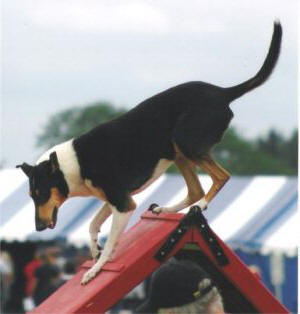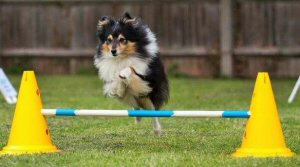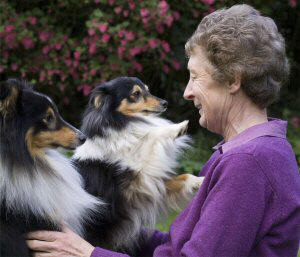Looking back on a
life in agility...
 Jean Tuck has just retired from agility after
a quarter of a century of running her dogs successfully. Age,
sciatica and not being able to manage long walks with her husband made her
re-evaluate her options, and sadly agility lost out. Looking back at her dogs over
the years, she's seen many changes in our sport. Jean Tuck has just retired from agility after
a quarter of a century of running her dogs successfully. Age,
sciatica and not being able to manage long walks with her husband made her
re-evaluate her options, and sadly agility lost out. Looking back at her dogs over
the years, she's seen many changes in our sport.
2022 started all right.
Then fuel
prices went up, and people started thinking about how far they could travel, how
often and whether it was better to do fewer shows for longer or just more local
shows, or perhaps just qualifiers. The number of people entering shows seemed to
drop, wondering if they
could even afford petrol to get to work let alone shows and many who entered
just didnít
turn up. Along with increased entry fees and the cost of travelling, the record-breaking heat
and hard ground last summer made me question whether I wanted to continue
running my dogs.
And that's what got me thinking about my past and
present dogs, and how agility has evolved over the last 25 years.
Starting out
I started agility in 1997 with a Sheltie
called Louis, a borderline Mini/Midi Sheltie with a large coat. While he enjoyed
jumping at pet training, he was obliged to run at the higher Midi height at the
time as there was no official measure. With hindsight, it is no wonder he lacked
confidence.
At the time, there were very few shows
offering classes for Midi dogs most of those were Open
which is the equivalent of our Combined 1-7 today. Opportunities to progress were tiny. Our trainer tried to get
Louis to jump full height which was higher than 'Large' is today. It put him right off, so we stuck to Midi and joined a Shelties-only
group which enabled him to enjoy agility and take part in the Sheltie limited
agility show. I decided to retire Louis, aged six, once he found the
spread too difficult to jump.
 Equipment
improvements Equipment
improvements
Obstacles at shows were non-standard. The tyre was either strung
into a rectangular metal frame or mounted on a thin pedestal like a lollypop.
The so-called 'soft' tunnels were often made of such a heavy fabric that many of
the Shelties
couldn't lift them enough to get through. Years later, they were taken out of
use as videos demonstrated how dangerous they could be.
Louis was
followed by Ross, a Smooth Collie
who absolutely loved agility. He could do an entire course with only one command
from me ('weaves')
and he was amongst the first dogs in the UK to gain an Agility Warrant when it was introduced.
Being a tall breed with long legs but without the flexibility of the Border
Collie, he found the steep angle of the A-frame made it very difficult to get the down
contact without toppling off, and big spread jumps were at the limit of his
jumping reach. Nevertheless, he won Elementary (G1) at his
first show in a class of
more than 100. That's when agility went from being our pastime to an obsession!
Ross went
on to win us out of Starters (G2) and then into Novice and Intermediate, the
latter being a huge class which the higher levels could also enter.
Heights re-organised
Measuring was introduced to determine which dogs would
fit which new height: Small, Medium and Large. Then at the beginning of 2006, the equipment height was
reduced. Louis measured Mini/Medium, so he
came out of retirement and enjoyed a short period of Mini before the new system
started. Medium suited him, and he even won a Novice class which also gained him
his last Agility Warrant points.
Ross also loved the new heights.
He could do
the small spread and the reduced A-frame much more comfortably. Sadly some older
Mini dogs had to retire as Small had a lower shoulder height limit than Mini, and they
couldn't cope with the stress of moving up to the higher Medium jumps.
 At the beginning of 2020 the new, lower jump
heights came in, along with Intermediate, a fourth height category. Older handlers who
had survived the increased minimum distances now had to contend with faster dogs
speeding over lower jumps. Even though I had planned ahead and taught Sheltie Zac more
distance handling than the others, it was still a struggle. Covid intervened and,
for a while, it was all academic anyway. At the beginning of 2020 the new, lower jump
heights came in, along with Intermediate, a fourth height category. Older handlers who
had survived the increased minimum distances now had to contend with faster dogs
speeding over lower jumps. Even though I had planned ahead and taught Sheltie Zac more
distance handling than the others, it was still a struggle. Covid intervened and,
for a while, it was all academic anyway.
Grades
restructured
In 2007, the Kennel Club introduced a new grade
system. Grades 1 and 2 (Elementary and Starters) and G6 and 7 (Senior and Advanced) matched existing
categories, but Novice had to be split into Grades 3, 4 and 5. Grades were
allocated
by looking at recent placings. Places of 5th or above meant Grade 5, which
both Louis and Ross achieved. My new Medium Sheltie
Scott who gained a 3rd at his first show in September 2006, had an
eye infection which ruled him out the following months, so he started in Grade 5, having
done only one show!
We enjoyed touring the shows, and Scotland
was well worth visiting since they ran graded classes more often than 'down
South.'
About this time the Agility Warrant scheme was extended to
include Silver and Gold, both of which Ross gained in January 2007. He got
his show title soon after, becoming the first of any breed to hold both a show
title and an AW.
Louis retired to Veteran in 2007,
while Ross retired the next year due to bad health, though he still enjoyed Veteran.
For a while, Scott was the only one running in actual classes.
Tiny Sheltie Glen joined us shortly after.
Thankfully the equipment was
becoming more standard with a tyre much like now being used. A
padded version was introduced, luckily for Ross who misjudged one badly,
probably due to very low sun, and crashed into it without injury. Breakaway tyres were still well in the future.
Scott became my first Grade 7 dog. He
acquired enough points for his AW/G and joined a Medium team which, in various incarnations, took him to
Crufts each year from 2009 to 2016, after which he retired to Veteran.
 Glen was
something else and proved that a non-sporty grandmother with little equipment
to train on can take a dog to the very top. Or to be more accurate, can
be taken to the top by her dog! He weighed just 4kg, looked uninterested on the
start-line, but seemed to run by telepathy. He taught himself running contacts
and only a wide variety of seesaw tipping-points held him back. Once he
conquered those, his confidence increased. Glen was
something else and proved that a non-sporty grandmother with little equipment
to train on can take a dog to the very top. Or to be more accurate, can
be taken to the top by her dog! He weighed just 4kg, looked uninterested on the
start-line, but seemed to run by telepathy. He taught himself running contacts
and only a wide variety of seesaw tipping-points held him back. Once he
conquered those, his confidence increased.
We travelled throughout the UK to benefit
from judges who set tricky, rather than fast, championship courses, collecting
Crufts Singles points along the way. Glen gained four tickets and six reserves
which
took him three times to Crufts. He also qualified three times by means of
Crufts Singles and was lucky enough to reach several Crufts finals.
Scott joined in, gaining two reserve tickets
and qualifying once for Crufts Singles, where he too reached the final.
Agility Warrants
In 2016 the AW scheme was extended again, this time to
include Platinum and Diamond. Glen became the first dog to gain the Platinum
warrant. Luckily for him, July that year saw the introduction of the lower
height for each height category, an interim measure until the height bands could
be restructured. Diagnosed that month with a terminal illness, he was able to
continue the sport he loved, at the lower height, and even gained his AW/D.
 Thus
we were left with an elderly Scott and a
young Medium Sheltie pup, Zac. We then had the chance to rehome a close relation
of Scott's, Maddie. She became our first girl. She had done a little pet agility and soon
joined Scott at shows who, at the time, was doing Veteran. She enjoyed Medium at
the lower
height when possible. Despite the culture shock of joining a competition home,
she soon gained confidence and worked her way to Grade 7. Thus
we were left with an elderly Scott and a
young Medium Sheltie pup, Zac. We then had the chance to rehome a close relation
of Scott's, Maddie. She became our first girl. She had done a little pet agility and soon
joined Scott at shows who, at the time, was doing Veteran. She enjoyed Medium at
the lower
height when possible. Despite the culture shock of joining a competition home,
she soon gained confidence and worked her way to Grade 7.
Increased distances
A change that
increased minimum distances between obstacles did have some impact on courses as flowing
lines of jumps were rare since fewer jumps fitted into the length of the rings.
In addition, the greater distances were not so suited to the strides and
strength of many smaller dogs - or sadly, to many older handlers. That didn't
matter to Zac, who was sturdier and faster, and reached Grade 7 in six months.
He and Maddie gained their AW/G the same weekend in 2019, and Zac added Platinum
shortly thereafter.
Post-Covid, the dogs
seemed as glad to be back as many of their handlers, though for some of them the
long break lead to retirement. Both mine enjoyed being back in action and
Zac was able to gain his AW/D. Driving long distances, however, had become less attractive,
so we were glad to benefit from shows in our own area.
After a few months off due to sciatica, we
managed some great shows this summer. Maddie, who continued to do some nice clear
rounds, was then in Veteran, and Zac finished our last show with a win.
 25 brilliant years of agility 25 brilliant years of agility
In my opinion, agility organisations and their members were
more determined to cope with restrictive regulations than most other dog
activities. They've been incredibly creative in the way they followed the
regulations while opening up agility.
What I do think is that all the changes
that have been
brought in have been with the welfare of the dogs in mind. Some may have had unintended
consequences to some dogs or competitors, but overall the care of dogs has been
the guiding factor. And how very enjoyable to have been part of a dog sport
where children right up to very senior citizens can compete in the same classes
with all their wonderful dogs.
Thank you to everyone who helped make them so good -
for the training, the shows and the company. Many canine activities fight
change, but in agility that is far less true. I have mentioned some of the
aspects that have altered over my 25 years, though doubtless I have missed as
many as I've mentioned.
I can now do the long walks,
so there has been a positive result, and the Shelties and I are finding
alternative ways of keeping busy including Tracking and Hoopers.
 About
the author... About
the author...
Jean Tuck got her first Sheltie when she was four, so that breed was an
obvious choice when she and husband Clive wanted a family dog for their daughter
and son. They all did basic training with Sam, but when Louis joined the family,
breed shows and Agility were added.
Jean and her dogs have enjoyed Obedience,
Rally, Scentwork and Trick Training.
First published
30th March 2023
|